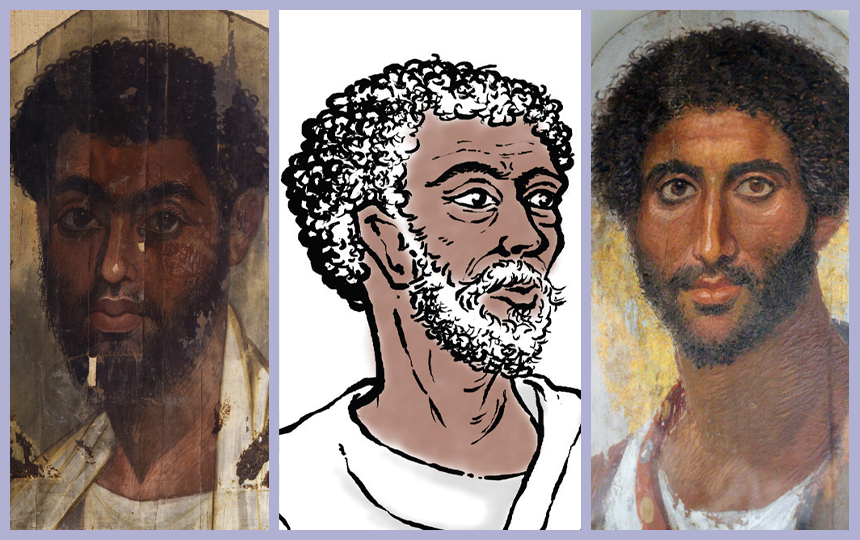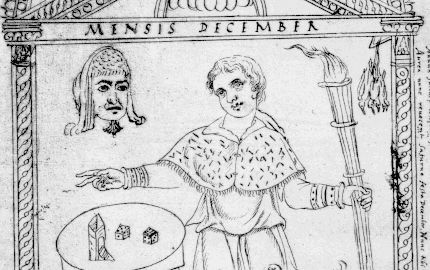The character Barbillus has made his way to Book I in the new UK and International edition. In this post, Director Caroline Bristow introduces the history behind the character and the evidence we used to better capture his Greco-Syrian-Egyptian heritage.

Submitted by Anonymous on Thu, 26/05/2022 - 11:59
Barbillus in the new edition of the CLC. On either side of him are the Fayum mummy portraits of two men that inspired his appearance in the textbooks. Both portraits date from the second century AD; the one on the right depicts a young officer wearing a sword belt.
The character of Barbillus has been an important figure in Book II onwards since the first edition of the Cambridge Latin Course. He offers hospitality to Quintus in Alexandria and his tragic deathbed desire to reconcile with his son is the very reason Quintus ends up in Britain. The new edition brings this character into the story much earlier to reduce the overwhelming number of new characters students meet in Book II (spoiler: yes, he survives the eruption!) and the number of one-hit-wonder characters in Book I. We first meet him when he comes to dinner in Stage 2 and at several other points in Book I, including during the eruption of Stage 12 (where he replaces the never-seen-before-or-after Julius).
In the CLC, Barbillus is a very successful Egyptian merchant and longstanding business associate and friend of Caecilius. He speaks several languages and has travelled a great deal. Although he is a cheerful and confident man, he has suffered a great deal throughout his life and carries a huge burden of guilt with him.
There is evidence to show that Caecilius had connections with traders from Alexandria in Egypt. One of the documents found in his house (CIL IV 3340.100) notes his involvement in an auction of linen on behalf of a man named Ptolemy of Alexandria. Barbillus mainly trades wine in the Bay of Naples, a reference to the many amphorae found in Pompeii from across the Roman empire, such as those excavated from the bar of Amarantus which show trading connections as far as Gaza and Cilicia.
The character was inspired by a real man named Tiberius Claudius Barbillus. He was from the city of Alexandria in Egypt and had an illustrious career during the first century AD. Amongst his many achievements, Barbillus was the imperial astrologer at Rome and the director of the famous Library at Alexandria (PIR C0813). The Roman author Seneca described Barbillus as ‘the best of men and exceptionally distinguished in every type of literature’ (Q. Nat. 4.13). He wrote an astrological treatise called the Astrologumena but only fragments of this have survived. While the CLC’s Barbillus has a very different career, we do learn of his keen interest in astrology and large personal library.
Tiberius Claudius Barbillus was the son of Egyptian Greek grammarian and astrologer Tiberius Claudius Thrasyllus (mentioned by Tacitus as a personal friend of the emperor Tiberius) and his mother may have been a member of the royal family of the Greco-Iranian Kingdom of Commagene. Despite these multicultural origins, the character of Barbillus in the Cambridge Latin Course was depicted with essentially European features. In the new edition, however, he has been re-drawn to reflect the Greco-Syrian-Egyptian heritage of the real Barbillus. Inspiration was taken from the famous Fayum mummy portraits that were popular in Roman Egypt from the first to third centuries AD. Like the two individuals depicted above, whose images were sent to our illustrator as a basis for Barbillus, these striking portraits bring us face-to-face with the multicultural communities who inhabited the Roman world.
From left to right: Photo © Andrea Jemolo / Bridgeman Images; Cambridge School Classics Project; Antikensammlung Berlin, photo by Sailko (cropped), CC BY 3.0








